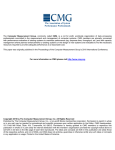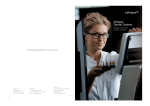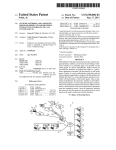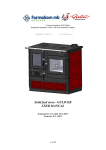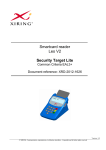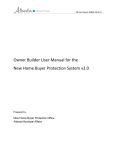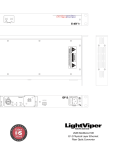Download L/ I 103 105 KBD p
Transcript
US007636548B2 (12) Ulllted States Patent (10) Patent N0.: Kraft et a]. (54) (45) Date of Patent: Dec. 22, 2009 EVENT HANDLING INA MOBILE 2005/0075096 A1 * 4/2005 Aljuraid ................ .. 455/4l4.l TERMINAL 2006/0074497 A1 * 4/2006 (75) Inventors: Christian Kraft, Erederiksberg C (DK); Peter Darn Nielsen, Lyngby (DK) (73) Assignee: Nokia Corporation, Espoo, FL (US) (*) US 7,636,548 B2 Notice: Subject to any disclaimer, the term of this patent is extended or adjusted under 35 U.S.C. 154(b) by 572 days. Pollin ........................ .. 700/14 FOREIGN PATENT DOCUMENTS EP 1111884 A2 EP 1241853 A2 6/2001 9/2002 EP 1349049 A1 10/2003 EP 1355468 A1 10/2003 OTHER PUBLICATIONS “User’s Manual for Nokia 9110 Communicator”, Issue 3 EN, 1999, 190 pages. (21) Appl. N0.: 11/073,407 (22) Filed; “Nokia 9210 Communicator User’s Guide”, Issue 3, 2001, 276 pages. Man 4, 2005 “Nokia 9300 User Guide”, Issue 1, 2004, 99 pages. “Nokia 9500 Communicator User Guide”, Issue 2, 2004, 105 pages. (65) Prior Publication Data US 2006/0199535 A1 European Of?ce Action dated Mar. 26, 2008. International Search Report dated Jun. 29, 2006. Sep. 7, 2006 _ _ * c1ted by examrner (51) Int. Cl. Primal,y ExammeriTuan . A Pham H043 7/00 (200601) (74) Attorney, Agent, or FirmiPerman & Green LLP (52) US. Cl. .............. .. 455/41.2; 455/4561; 455/4563; (58) Field of Classi?cation Search .............. .. 455/41.2, 455/456.6; 370/328; 370/338 455/4561, 456.3, 456.6, 567; 370/328, 338 See application ?le for complete search history. (56) (57) ABSTRACT A method for triggering an event in a mobile communication terminal, Where the terminal is capable of operating in any References Cited one of a pluralrty of selectable states, the method comprises the steps of: receiving scheduling information When the ter U.S. PATENT DOCUMENTS minal is in a ?rst operational state, the information specifying $1 : garnish et a1‘ """""" "4535332468? triggered When the mobile communication terminal has tran 2002/0052225 A1 2002/0090931 A1 * 2003/0085766 A1 * 5/2002 Davis et a1. 7/2002 Papineau et al. 455/411 5/2003 Rogerson ................... .. 331/57 that an event in the mobile terminal is to be scheduled to be 2 , , esc ................... .. . - - Smoned to a Second State‘ 18 Claims, 3 Drawing Sheets *\~ 123 115 1 13 \ L/ I DISP “3 121 '\/\ / 103 TRX "\_ 119 CPU I \ 107 KBD p‘ l 11 7 ( 111 MEM '-\_ 109 N 101 105 US. Patent Dec. 22, 2009 Sheet 1 0f 3 US 7,636,548 B2 "\- 123 115 113 121\\/?Q 103 105 L/ DISP “3 TRX '\119 CPU \ 107 K‘iD p MEM~109 N 101 Fig. 1 US. Patent Dec. 22, 2009 Sheet 3 of3 US 7,636,548 B2 START Receive 310“- scheduling information 320'” 330 340-» IDLE ‘ Desired state Trigger event End Fig. 3 US 7,636,548 B2 1 2 EVENT HANDLING IN A MOBILE TERMINAL The object is achieved in a ?rst aspect by a method for triggering an event in a mobile communication terminal, Where the terminal is capable of operating in any one of a TECHNICAL FIELD plurality of selectable states. The method comprises the steps of: receiving scheduling information When the terminal is in The present invention relates to a method and mobile com munication terminal to control the triggering of events in a mobile communication terminal. a ?rst operational state, the information specifying that an event in the mobile terminal is to be scheduled to be triggered When the mobile communication terminal has entered a sec ond state. The event is triggered When the mobile communi cation terminal has entered the second operational state. In BACKGROUND this Way, the user can schedule events When he or she has a lot Mobile communication terminals have changed dramati cally in the last decade. With the ?rst 2 G terminals, the only of time, for execution at a time When he or she knoWs that many activities need to be performed simultaneously. In a preferred embodiment of the invention, the ?rst opera real purpose Was to make normal phone calls. NoW With 2.5 G (GPRS), CDMA2000 and UMTS technology, coupled With tional state is When the terminal is radio silent. This covers the case for When the terminal is in ?ight mode. softWare applications such as a calendar application, a contact list application and a task list application, the mobile com munication terminals have evolved to take on the role of being In a preferred embodiment of the invention, the second operational state is a normal mode. Normal mode is When the terminal returns to a normal operational mode e. g. When it is PDAs (Personal Digital Assistant), in addition to being com munication devices. A problem found With using the mobile communication 20 communication terminal may be prohibited in some situa tions, such as in hospital environments and While ?ying on airplanes. This has been solved With What is called ‘?ight mode’, Which is knoWn in the art. Flight mode implies that transmission and reception of radio signals in addition to softWare components requiring radio interfaces are disabled, While software components that do not use any radio inter faces are still available to the user. For example, in ?ight mode it is not possible to make phone calls, but the calendar appli cation is available. Consequently, While in ?ight mode, the ously scheduled events triggered. In a preferred embodiment of the invention, the ?rst opera 25 devices are Within range for the short range RF transceiver. In other Words, events can be scheduled to be executed once the 30 ponents again and When it happens the user might be pre occupied With other tasks the user might forget that he Was In a preferred embodiment of the invention, the short range RF transceiver is a Bluetooth® transceiver and the short range RF device is a Bluetooth® device. Bluetooth® is one of the 35 most commonly used short range RF technologies. In a preferred embodiment of the invention, the event is a transfer of data to or from the terminal. Thus the user can easily schedule the transfer of data for When no untrusted devices are in the proximity, enhancing the security of such transfer. In a preferred embodiment of the invention, the event is activation of a reminder. For example, a user may Wish to be reminded to call relatives once the user is out of the hospital. In a preferred embodiment of the invention, the event is to 45 synchroniZe a clock in the terminal With timing information available in a mobile communication netWork to Which the terminal connects to When entering the second state. This can be advantageous for example after having traveled a great 50 supposed to make a call and the reminder Will then have been to no use. Another reason for a user desiring, or even being com pelled, to temporarily disable radio communication is that of integrity and security While using short range RF. For example, When using a Bluetooth® transceiver in the mobile security risks of having untrusted devices in the proximity have diminished. exit the airport or to catch another plane, etc. Thus for the user to make desired changes in the mobile communication termi nal for the neW location is stressful and easily forgotten until a later, less optimal, time. If a call reminder Were to go off While the user is on a plane or someWhere else Where the user is unable to make the call in the reminder, the user Would then be forced to Wait until he is alloWed to sWitch on the RF components again. As some time could pass before the terminal is alloWed to use the RF com tional state is When at least one untrusted short range RF device is Within range for a short range RF transceiver in the terminal. The second state is When only trusted short range RF terminal is safe to operate While the user is located on an airplane in ?ight or in a hospital environment. One problem occurs When the user exits ?ight mode, eg when returning to ground again after having been on an airplane or When exiting a hospital environment and the user Wishes to set the terminal to be in normal operation mode. At this point in time, the user is typically busy With several activities, such as disembarking the plane, ?nding Where to capable of receiving and transmitting a call after having been in another mode, such as ?ight mode. This is a typical example of When it is useful for the end user to have previ terminal as a PDA is that radio traf?c generated from a mobile distance and landing in a neW time Zone, ensuring that the clock in the terminal is set to the correct local time. In a preferred embodiment of the invention, the event is to scan and store available broadcast radio stations. Again, this can With advantage be used When stepping off a plane in a neW location, alloWing a set of broadcast radio stations to be easily 55 available to the user. Another aspect of the present invention is a mobile com munication terminal comprising a processor and memory communication terminal to send or receive data, it may be desired for security reasons to ?rst check if there are any con?gured to perform the method described above and pro viding the same advantages as described above. untrusted Bluetooth® devices Within range, and only proceed The folloWing is a description of tWo use cases to illustrate With the transfer if no untrusted devices are found. This pro the usefulness of the invention. cedure can be both time consuming and irritating for the user. The ?rst use case is When a user gets a reminder to make a a user faces When using a mobile communication terminal as call While in ?ightmode. As it is not alloWed to start up the RF part of the device he is unable to make the call and thus the reminder is redundant at this point and might only serve as a distraction and stress the user. According to the present inven described above. tion, the terminal Would automatically check Whether it is SUMMARY OF THE INVENTION An object of the present invention is to alleviate problems 65 US 7,636,548 B2 3 4 possible to perform the required action ie to make the phone being for storing data and program instructions for various call and if it is not possible the action is postponed to a later softWare in the mobile terminal. The softWare includes a time. This could either be done by simply postponing the reminder or by associating it With a pro?le change going from Flightmode to another mode alloWing RF activity or When real-time operating system 220, man-machine interface contact With an operator has been established. 260, 270 may include a call handling application as Well as various other application, such as a contacts (phonebook) (MMI) drivers 234, an application handler 232 as Well as various applications 250, 260, 270. The applications 250, Alternatively, postponing the action could be supple application, a messaging application, a calendar application, mented With keeping the original reminder as Well. In the use case above, this Would result in both a reminder going of While in ?ight mode and one going off as contact With an operator has been established. This Would alloW the user to look for alternative modes of communication such as airplane a control panel application, a camera application, a media player, one or more video games, a notepad application, etc, including softWare capable of performing a method accord ing to the invention as described beloW in connection With FIG. 3. The MMI drivers 234 cooperate With the or each display phones While still being certain that should he fail he Will be reminded again When it is possible. The second use case is When a terminal has a scheduled BluetoothTM synchronize session or When a user initiates a 236 as Well as various other I/O devices 238, 239 such as a microphone, a speaker, a vibrator, a keypad, a ringtone gen erator, a LED indicator, volume controls, etc. As is commonly knoWn, a user may operate the mobile terminal through the man-machine interface thus formed. synchronization. The terminal Would then sense if there are any unfriendly device around, ie any devices that are not on the trusted list, any unknoWn devices or any devices on a blacklist depending on the desired security. If so, the terminal automatically postpones the synchronization to a later time 20 The softWare also includes various modules, protocol 25 stacks, drivers, etc., Which are commonly designated as a softWare block 230 and Which provide communication ser vices (such as transport, netWork and connectivity) for an RF interface 206, and optionally a Bluetooth® interface 208 and/or an IrDA interface 210. The RF interface 206 comprises When there are only friendly devices around either by post poning and trying again or by monitoring the environment and initiating the synchronization When the criteria is ful ?lled. an internal or external antenna as Well as appropriate radio BRIEF DESCRIPTION OF THE DRAWINGS circuitry for establishing and maintaining a Wireless link to a base station in a mobile communication netWork. As is Well knoWn to a person skilled in the art, the radio circuitry com The present invention Will be more apparent from the accompanying draWings, provided as non-limiting examples. FIG. 1 schematically illustrates a functional block diagram of a mobile communication terminal according to an embodi ment of the present invention. FIG. 2 schematically illustrates a block diagram represent ing the general internal component and softWare structure of 30 The mobile terminal also has a SIM card 204 and an asso ciated reader. As is commonly knoWn, the SIM card 204 35 a mobile communication terminal according to an embodi FIG. 3 is a ?owchart of a method according to an embodi described above Without continuous exclusive use of the con ment of the present invention. troller (eg 200 in FIG. 2). Consequently, several softWare 40 PREFERRED EMBODIMENTS execution is Well knoWn in the art and is often referred to as In a receive scheduling information step 310, the terminal 45 knoWn systems CDMA2000, D-AMPS, GSM, UMTS, 109 as Well as input/output units in the form of a microphone responsible for the overall operation of the mobile terminal 50 Non-limiting examples of events that may be scheduled in 55 netWork, a search and store of available local broadcast radio stations. In an idle state 320, the execution ?oW temporarily rests alloWing other softWare modules in the terminal to execute before executing the next step. 60 cessor”) or any other electronic programmable logic device. The controller 200 has associated electronic memory 202 is used for various purposes by the controller 200, one of them Ways, such as in a received data message, such as an SMS or an MMS received over the air. step 310 are: a reminder With a user speci?ed text, a synchro nization of the terminal clock With a time available in the and is preferably implemented by any commercially available CPU (“Central Processing Unit”), DSP (“Digital Signal Pro such as RAM memory, ROM memory, EEPROM memory, ?ash memory, or any combination thereof. The memory 202 receives information to schedule an event to be triggered in the future. Included in this information is an event to be triggered and a desired state the terminal should have transi tioned to When triggering the event. This information is pref erably entered by the user, but could also be provided in other EDGE, etc. The terminal comprises a processor 107, memory antenna 121. Connected to the radio communication netWork 105 is a controller 123. The details regarding hoW these units communicate are knoWn to a person skilled in the art and is therefore not discussed further. The internal component and softWare structure of a mobile communication terminal according to an embodiment of the present invention Will noW be described With reference to FIG. 2. The mobile terminal has a controller 200 Which is programs or modules can share use of the controller. Such multitasking. 103 With a radio communication netWork 105 such as the Well 111, a speaker 113, a display 115 and a keyboard 117. Radio communication is realized by radio circuitry 119 and an comprises a processor as Well as local Work and data memory. FIG. 3 shoWs a ?oWchart of a method according to an embodiment of the present invention. The execution of the steps illustrated is preferably executed in a terminal such as ment of the present invention. FIG. 1 illustrates schematically a communication terminal 101 in Which the present invention is implemented. The ter minal 101 is capable of communication via an air interface prises a series of analog and digital electronic components, together forming a radio receiver and transmitter. 65 In a desired state step 330, it is determined Whether the current state of the terminal corresponds to the desired state. If the terminal is in the desired state, the execution ?oW continues to step 340, otherWise the execution ?oW goes back to step 320. The determination is performed, as the skilled person Will realize, by interaction With other softWare or hardWare components in the terminal having information about What operational state the terminal is presently in. US 7,636,548 B2 6 5 receive scheduling information When said terminal is in a ?rst operational state, said information specifying In a trigger event step 340, the event speci?ed in step 310 is triggered. The action and result of the triggering is, as the skilled person Will realize, performed With interaction With other software and hardWare components in the terminal. This may result, for example, in visual output on the display, sound output to the speaker or a change in information in another softWare module. While the execution described above only refers to one scheduled event, it is Within the scope of present invention to that an event in said mobile terminal is to be scheduled to be triggered When said mobile communication ter minal has entered a second operational state, and trigger said event When said mobile communication ter minal has entered said second operational state Wherein said ?rst operational state is When at least one untrusted short range RF device is Within range for a short range RF transceiver in said terminal, and said schedule any number of events. On any state transition, any second operational state is When only trusted short event or events associated With the neW state Will be triggered. As a person skilled in the art Will realiZe, the claimed range RF devices are Within range for said short range RF transceiver. invention could just as Well be achieved if the event is trig gered When carrying out a transition to the desired state itself. 10. The terminal of claim 9 Wherein said ?rst operational state is When said terminal is radio silent. 11. The terminal of claim 9 Wherein said second state is a In other Words, in stead of periodically having to check if the terminal is in the desired state, the transition itself could trigger any scheduled events. normal operational mode. The invention claimed is: 1. A method comprising: receiving scheduling information in a mobile communica 20 tion terminal When said terminal is in a ?rst operational state, said information specifying that an event in said mobile terminal is to be scheduled to be triggered When said mobile communication terminal has entered a sec ond operational state, and of a reminder. 25 triggering said event When said mobile communication terminal has entered said second operational state range RF transceiver is a Bluetooth® transceiver and said short range RF device is a Bluetooth® device. available in a mobile communication netWork to Which said state. 30 17. An apparatus comprising 35 40 a transfer of data to or from said terminal. 6. The method according to claim 1, Wherein said event is activation of a reminder. 45 said terminal connects to When entering said second opera tional state. to scan and store available broadcast radio stations. 9. A mobile communication terminal comprising: a processor; and a memory coupled to the controller, the memory having program instructions stored thereon, the program instructions being con?gured to cause the controller to: receive scheduling information in a mobile communica tion terminal When the terminal is in a ?rst operational state, the information specifying that an event in the mobile terminal is to be scheduled to be triggered When the mobile communication terminal has entered a second operational state; and trigger the event When the mobile communication ter minal has entered the second operational state Wherein said ?rst operational state is When at least one untrusted short range RF device is Within range for a short range RF transceiver in said terminal, and said second operational state is When only trusted short tion available in a mobile communication netWork to Which 8. The method according to claim 1, Wherein said event is 16. The terminal of claim 9 Wherein said event is to scan and store available broadcast radio stations. a controller; and 5. The method according to claim 1, Wherein said event is 7. The method according to claim 1, Wherein said event is to synchronize a clock in said terminal With timing informa 15. The terminal of claim 9 Wherein said event is to syn chroniZe a clock in said terminal With timing information terminal connects to When entering said second operational Wherein said ?rst operational state is When at least one untrusted short range RF device is Within range for a short range RF transceiver in said terminal, and said second operational state is When only trusted short range RF devices are Within range for said short range RF transceiver. 2. The method according to claim 1, Wherein said ?rst operational state is When said terminal is radio silent. 3. The method according to claim 1, Wherein said second state is a normal operational mode. 4. The method according to claim 1, Wherein said short 12. The terminal of claim 9 Wherein said short range RF transceiver is a Bluetooth® transceiver and said short range RF device is a Bluetooth® device. 13. The terminal of claim 9 Wherein said event is a transfer of data to or from said terminal. 14. The terminal of claim 9 Wherein said event is activation 50 range RF devices are Within range for said short range RF transceiver. 18. The apparatus according to claim 17, Wherein the ?rst operational state is When the terminal is radio silent and the second state is a normal operational mode. a memory Where the processor and memory are con?gured to * * * * * UNITED sTATEs PATENT AND TRADEMARK OFFICE CERTIFICATE OF CORRECTION PATENT NO. : 7,636,548 B2 Page 1 of 1 APPLICATION NO. : 11/073407 DATED : December 22, 2009 INVENTOR(S) : Kraft et al. It is certified that error appears in the above-identified patent and that said Letters Patent is hereby corrected as shown below: Title page, item (73); column 1, line I delete “FL” and insert --FI-- therefor. Column 6, line 32 delete “comprising” and insert --comprising:-- therefor. Signed and Sealed this Thirteenth Day of July, 2010 David J. Kappos Director of the United States Patent and Trademark Of?ce









